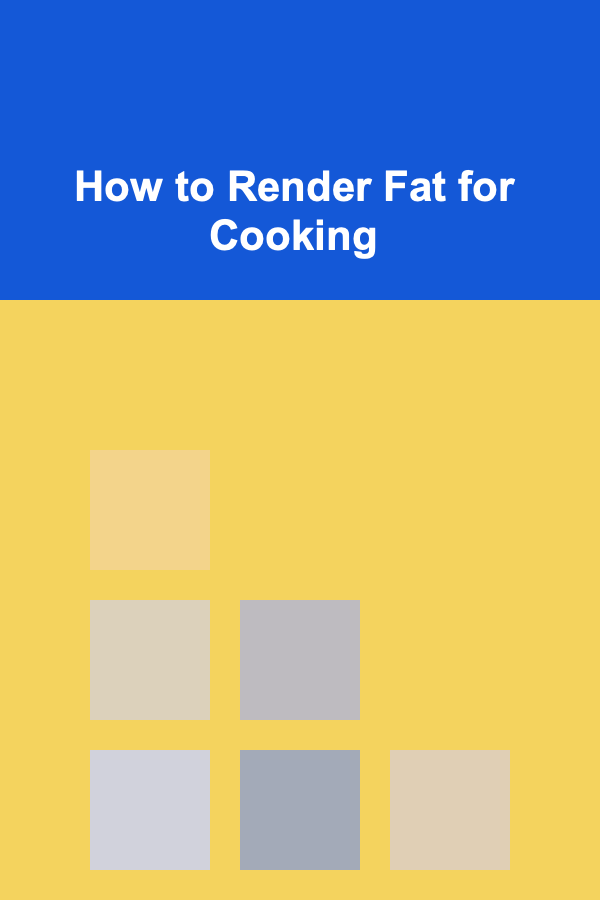
How to Render Fat for Cooking
ebook include PDF & Audio bundle (Micro Guide)
$12.99$5.99
Limited Time Offer! Order within the next:

Rendering fat is a timeless culinary technique that has been used for centuries to produce one of the most essential cooking ingredients---fat. Fat not only adds flavor and texture to dishes but also plays a significant role in the cooking process, from frying to sautéing. This process is simple yet crucial, allowing cooks to utilize fats like pork, beef, duck, or even chicken to enhance the taste and aroma of their meals. In this article, we will delve deep into the art of rendering fat, its history, types of fat that can be rendered, and its many uses in modern and traditional cooking.
What Is Fat Rendering?
Rendering fat is the process of slowly heating animal fat to separate the solid components from the liquid fat. During this process, the fat melts and is strained to remove any impurities, resulting in a pure form of fat. Rendered fat can then be used for cooking, baking, or as a base for various recipes. The method of rendering fat varies depending on the type of fat being used, but the concept remains the same: slow, steady heat to melt the fat and eliminate any solids.
The History of Fat Rendering
Fat rendering has a long history that dates back to ancient civilizations. Early humans discovered the usefulness of animal fats in cooking, and they soon learned how to extract and preserve the fat for future use. In medieval times, rendered fats were an essential part of daily life and were used not only for cooking but also for preserving food. For example, lard (rendered pig fat) was used to preserve meats, as it could be poured over food to create an airtight seal.
In modern cooking, fat rendering has seen a resurgence, as many chefs and home cooks have turned to more traditional methods for creating richer, deeper flavors. Today, rendered fats are considered a staple in various cuisines, particularly in French, Italian, and Southern American cooking.
Types of Fat That Can Be Rendered
Several types of animal fats can be rendered for cooking. Each type of fat has its unique flavor profile and cooking properties, making them ideal for different applications. Let's explore the most common fats that are rendered:
1. Pork Fat (Lard)
Lard, which is rendered from the fat of pigs, is one of the most well-known fats used in cooking. It has a rich, savory flavor and is commonly used in baking, frying, and sautéing. Lard is particularly popular in Southern and Latin American cooking, where it is used to create flaky pastries, fry tortillas, or sauté vegetables. Lard is also a key ingredient in classic dishes like fried chicken and carnitas.
When rendered correctly, lard can be quite neutral in flavor, making it versatile for many different recipes. It is a great fat for high-heat cooking and can be used for deep frying due to its high smoke point.
2. Beef Fat (Tallow)
Tallow is rendered beef fat and is a staple in many traditional recipes. It has a beefy flavor and is often used in dishes that require a strong, savory base. Tallow is most commonly used in deep frying, especially for frying potatoes, as it imparts a rich flavor to French fries and other fried foods.
Tallow is also prized for its ability to create a crisp texture when used in baking, particularly for pie crusts and pastries. It has a high smoke point, making it ideal for high-heat cooking methods like frying and roasting.
3. Duck Fat
Duck fat is considered a delicacy in many culinary traditions. It is rendered from the fat of ducks and has a rich, luxurious flavor. Duck fat is commonly used in French cuisine, particularly in dishes like confit de canard (duck confit), where the duck is slow-cooked in its own fat to create a tender, flavorful meat.
Duck fat is also great for roasting vegetables, especially potatoes, as it creates a crispy exterior and a rich flavor. Its relatively high smoke point makes it suitable for frying, sautéing, and searing, and it adds a unique flavor to any dish.
4. Chicken Fat (Schmaltz)
Schmaltz is the rendered fat from chicken or other poultry. It is a common ingredient in Jewish cuisine and is used in many traditional dishes like matzo ball soup, kugel, and chopped liver. Schmaltz has a distinct, savory flavor that enhances the richness of the dish.
While schmaltz is a beloved ingredient in various cuisines, it can also be used for sautéing, frying, or even as a spread for bread. Chicken fat has a moderate smoke point, making it suitable for medium to high-heat cooking.
5. Goose Fat
Goose fat is similar to duck fat but has a slightly more delicate flavor. It is often used in French and European cooking, particularly for roasting meats and vegetables. Goose fat is highly regarded for its ability to create crispy skin on roasted meats and vegetables.
Like duck fat, goose fat has a high smoke point and is excellent for frying, sautéing, and roasting. It is also often used in the making of confit, particularly for goose or duck legs, where the meat is slow-cooked in the rendered fat until it becomes tender and flavorful.
6. Lamb Fat
Lamb fat, while less commonly rendered than the other types of fat, has a unique, gamey flavor that can be used to enrich certain dishes. It is often rendered for use in Mediterranean or Middle Eastern recipes, where it can be used to sauté vegetables, cook meats, or create a rich base for stews and soups.
Lamb fat has a medium smoke point, so it's best used for low to medium heat cooking, where its strong flavor can be incorporated into the dish without being overpowered.
The Rendering Process
Now that we have an understanding of the different types of fats that can be rendered, let's explore the actual process of rendering fat. While the process is straightforward, it requires patience and attention to detail to achieve the best results.
1. Preparing the Fat
The first step in rendering fat is to gather the fat and prepare it for the rendering process. If you are working with a whole animal, you will need to trim the fat from the meat. You can either ask your butcher for specific cuts of fat, such as pork belly fat, beef suet, or duck fat, or you can use leftover scraps of fat from other meats.
Once you have your fat, it's important to cut it into small, uniform pieces. The smaller the pieces, the quicker they will melt. If the fat is not pre-cut, use a sharp knife to chop it into chunks that are roughly the size of dice or smaller.
2. Choosing a Method of Rendering
There are two primary methods for rendering fat: slow cooking and dry rendering. Both methods involve applying gentle heat to the fat to melt it down, but they differ in the approach.
Slow Cooking (Wet Rendering)
Slow cooking, or wet rendering, is the most common method used for rendering fat. This method involves simmering the fat in a small amount of water, which helps to keep the fat from burning while allowing it to melt slowly.
Here's how to render fat using the slow cooking method:
- Place the cut fat into a large pot or Dutch oven.
- Add a small amount of water (just enough to cover the bottom of the pot) to prevent the fat from sticking or burning.
- Cook the fat over low heat, stirring occasionally, until the fat has melted and the solid pieces (cracklings) are golden brown.
- Once the fat is fully rendered, strain it through a fine mesh strainer to remove the cracklings and any impurities.
Dry Rendering
Dry rendering is a faster method, which doesn't require water. Instead, the fat is placed directly into a pan or skillet over low to medium heat. As the fat heats up, it melts and begins to separate from the solids. The key to dry rendering is to avoid overheating the fat, as it can become too browned or even burnt.
Here's how to dry render fat:
- Place the cut fat into a heavy-bottomed pan or skillet.
- Cook the fat over low to medium heat, stirring occasionally to ensure even melting.
- Once the fat has fully melted, remove the solid pieces (cracklings) and strain the rendered fat.
3. Straining the Fat
After rendering the fat, it's important to strain it to remove any remaining solid particles and impurities. This can be done by pouring the melted fat through a fine mesh strainer, cheesecloth, or coffee filter. The goal is to end up with a clear, clean fat that is free from debris.
4. Storing Rendered Fat
Once the fat is rendered and strained, it's essential to store it properly. Rendered fat should be stored in an airtight container, and it can be kept in the refrigerator for up to a month or frozen for longer-term storage. The fat will solidify as it cools, so it can be scooped or spooned out as needed.
Uses of Rendered Fat in Cooking
Rendered fats are incredibly versatile and can be used in a wide range of cooking techniques and recipes. Here are some common ways rendered fat can be used in cooking:
- Frying: Rendered fats like lard, tallow, and duck fat are excellent for deep frying, as they have high smoke points and can impart rich flavor to fried foods.
- Sautéing: Rendered fats are perfect for sautéing vegetables, meats, and other ingredients, as they help to create a crisp, golden exterior while keeping the interior tender and flavorful.
- Roasting: Using rendered fat for roasting vegetables or meats adds flavor and helps achieve a crispy, caramelized exterior.
- Baking: Some rendered fats, like lard or tallow, are commonly used in baking for pie crusts, biscuits, and other pastries. They help create a flaky, tender texture.
- Flavoring: Rendered fat can be used as a base for soups, stews, and gravies, where it adds a rich, savory depth to the dish.
Conclusion
Rendering fat is a simple yet incredibly important skill for any home cook or professional chef. By understanding the process and the various types of fat that can be rendered, you can enhance your cooking and add depth and flavor to your dishes. Whether you're frying, sautéing, roasting, or baking, rendered fat is a versatile and essential ingredient that has been used for centuries to create delicious meals. So, next time you find yourself with some leftover fat, don't throw it away---render it, store it, and use it to elevate your cooking to new heights.

How to Build a Family Scrapbook Together: Tips and Ideas
Read More
How to Make the Most of Nooks and Crannies for Extra Storage
Read More
How to Save Money on Insurance Premiums
Read More
How To Understand Small Business Contracts
Read More
How to Find TV Shows That Celebrate Diversity
Read More
Finding the Perfect Blend: How to Find TV Shows That Are Both Funny and Touching
Read MoreOther Products

How to Build a Family Scrapbook Together: Tips and Ideas
Read More
How to Make the Most of Nooks and Crannies for Extra Storage
Read More
How to Save Money on Insurance Premiums
Read More
How To Understand Small Business Contracts
Read More
How to Find TV Shows That Celebrate Diversity
Read More